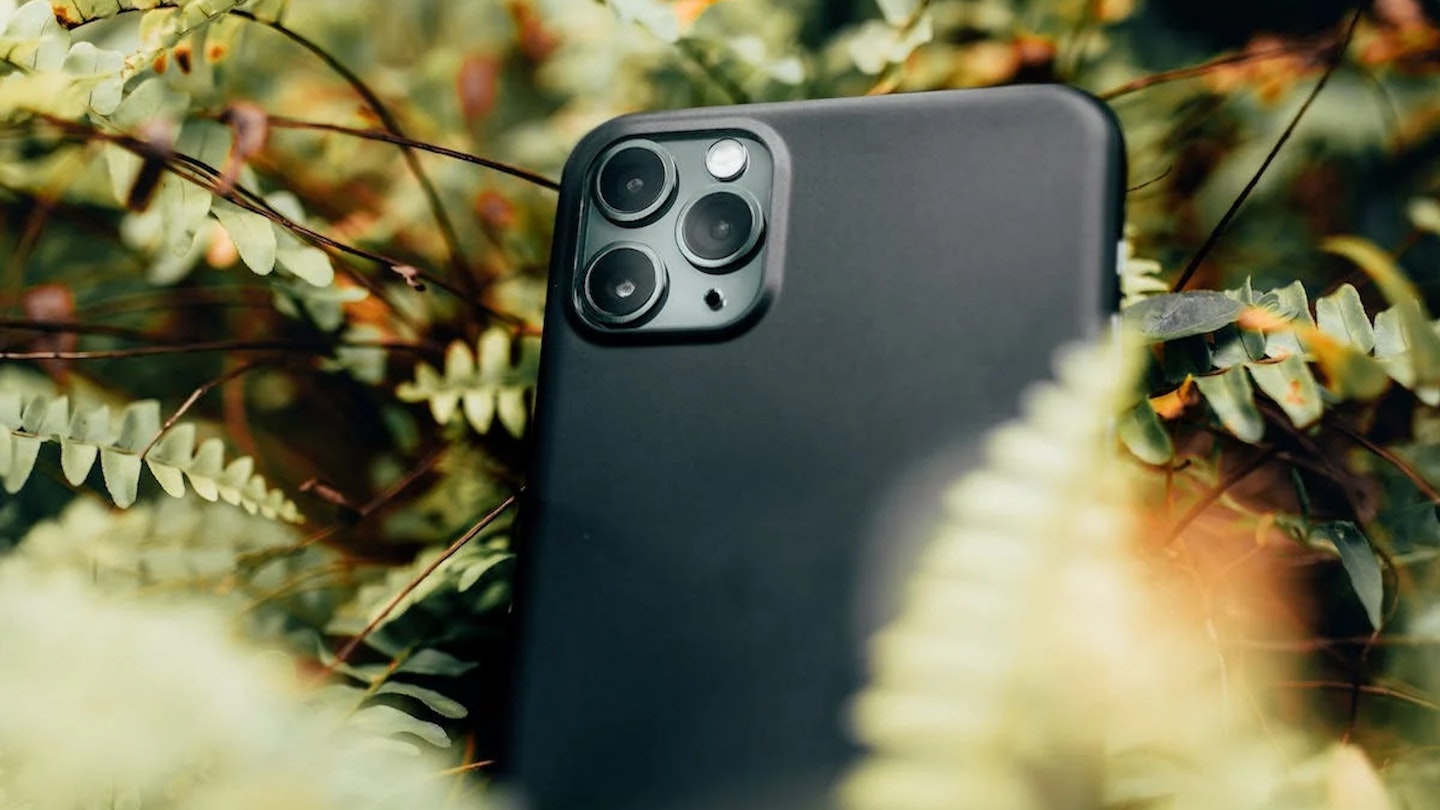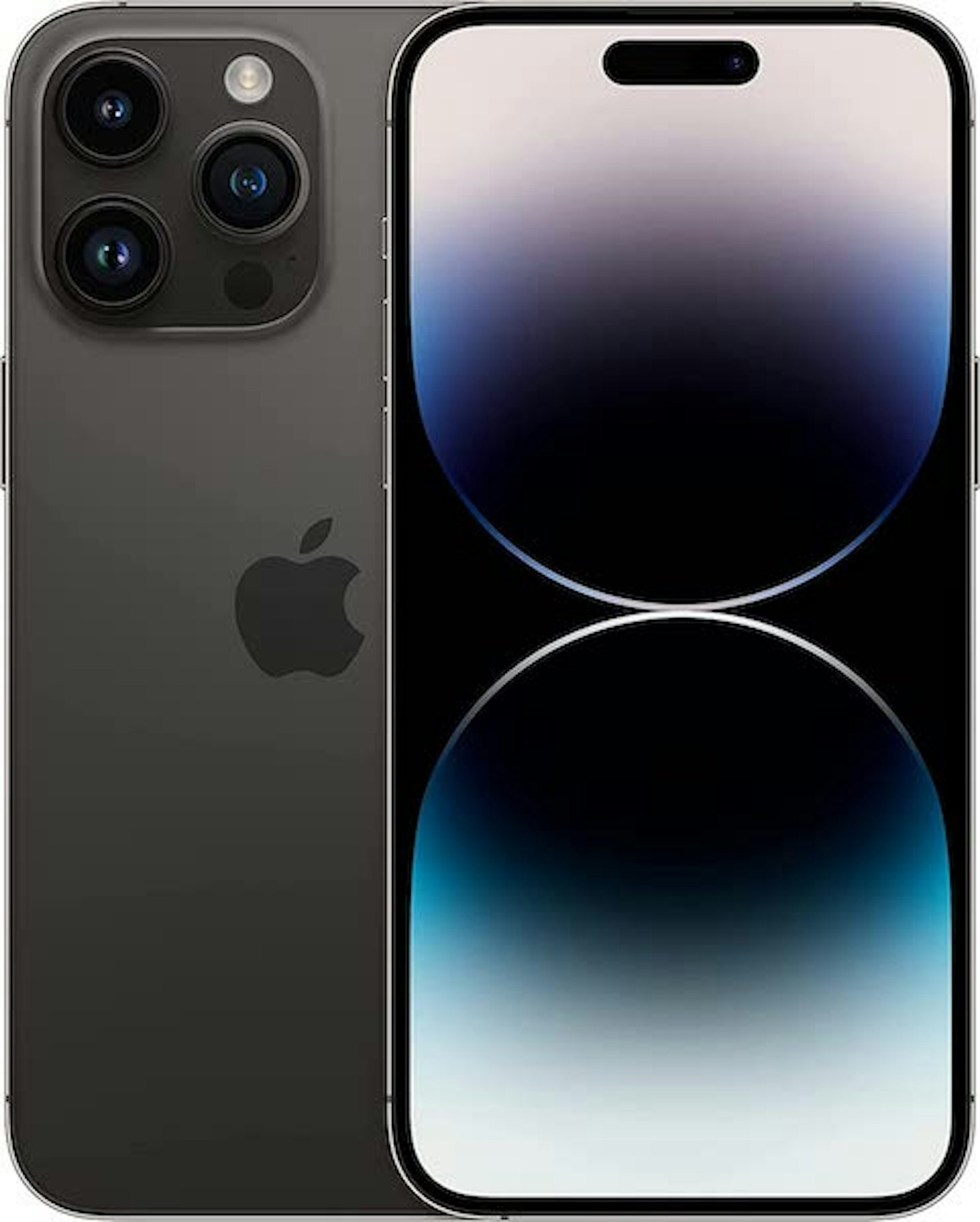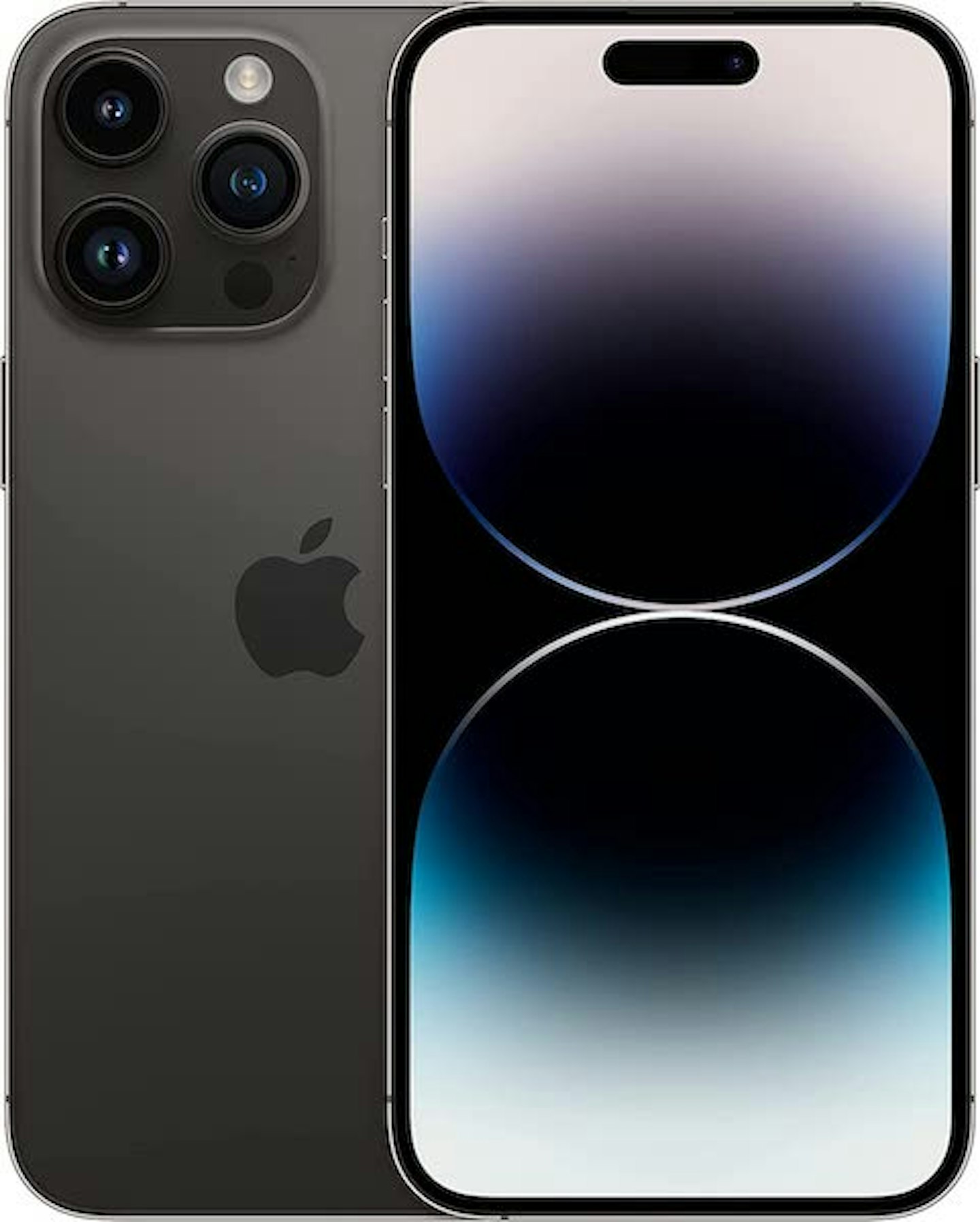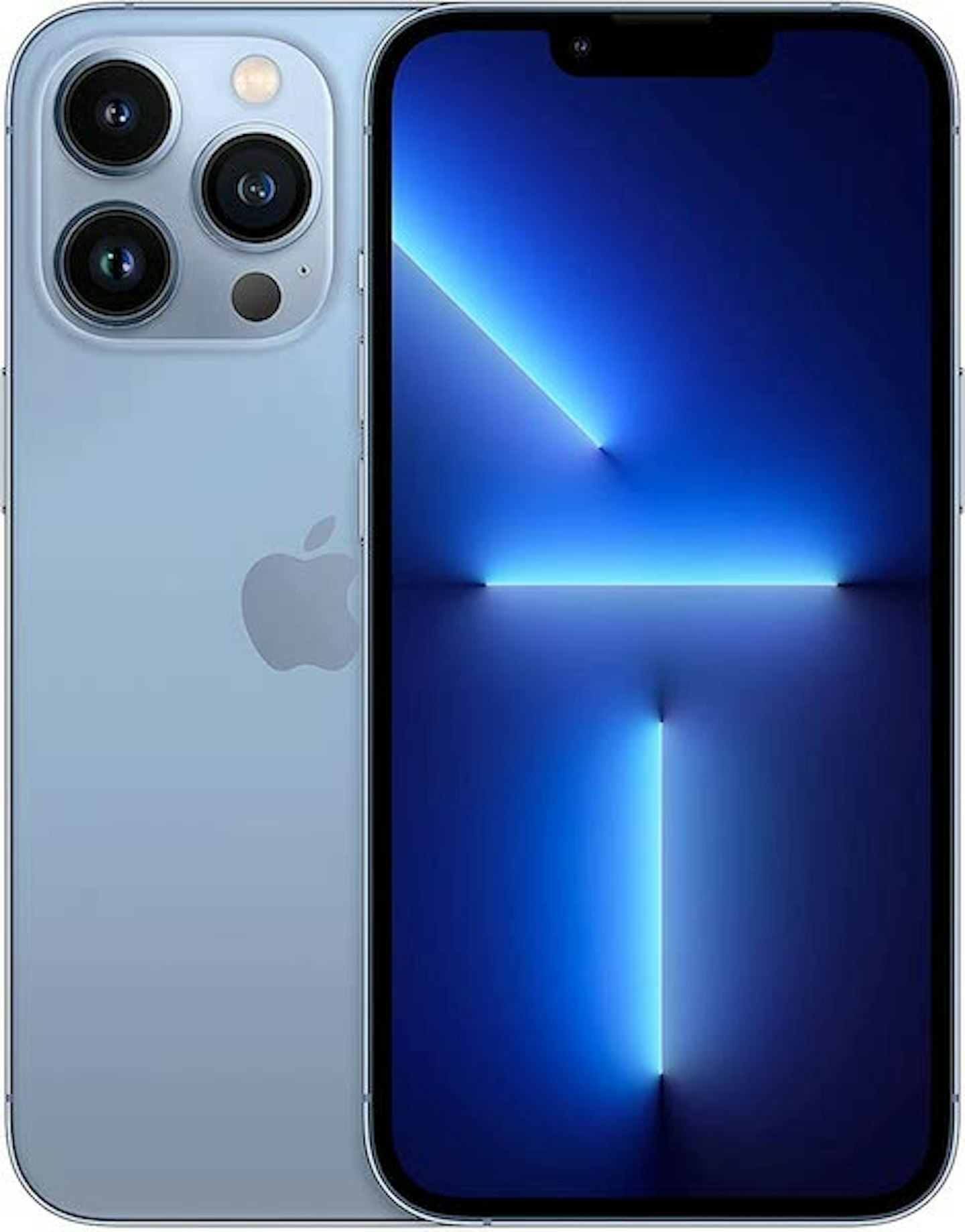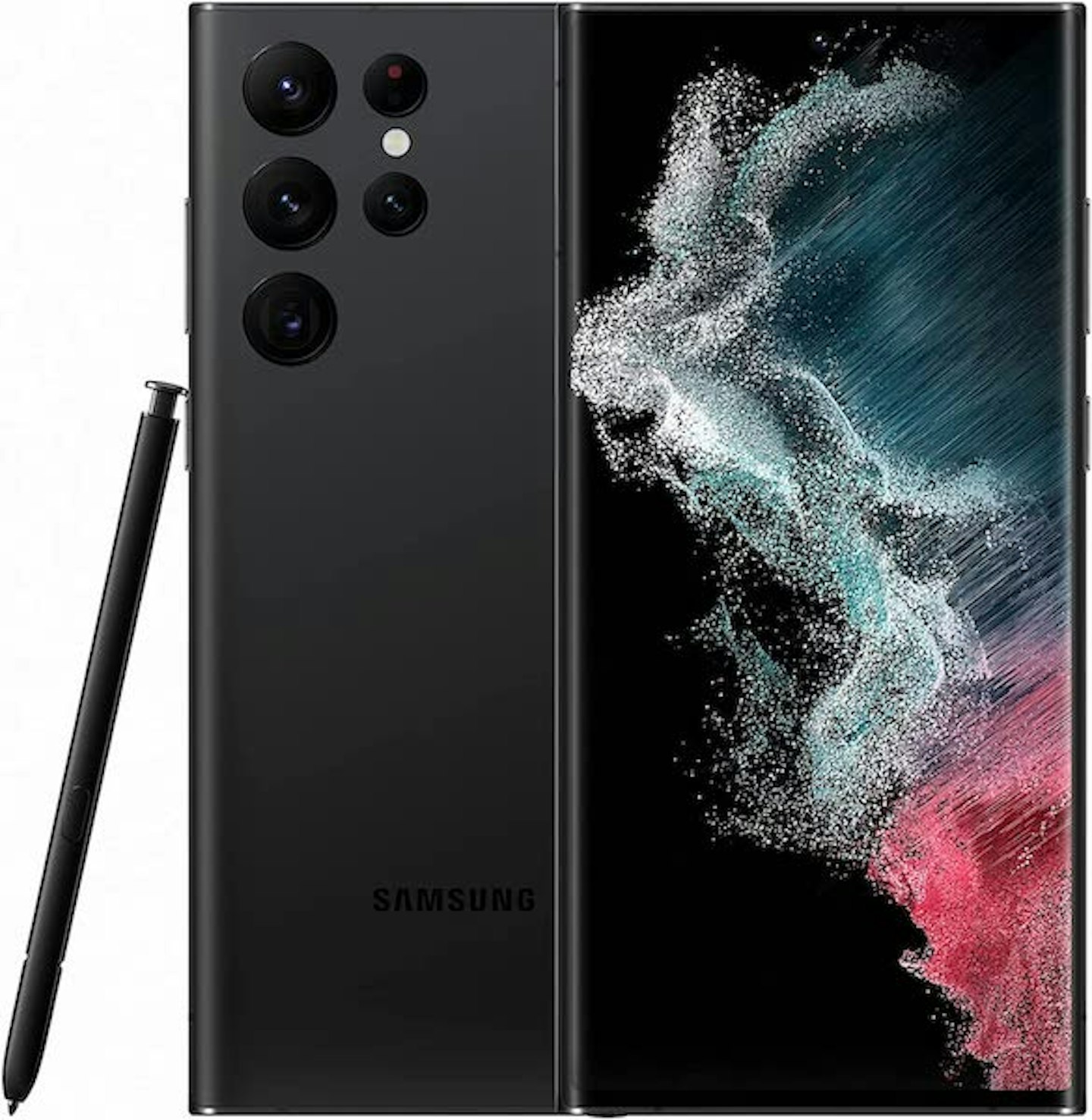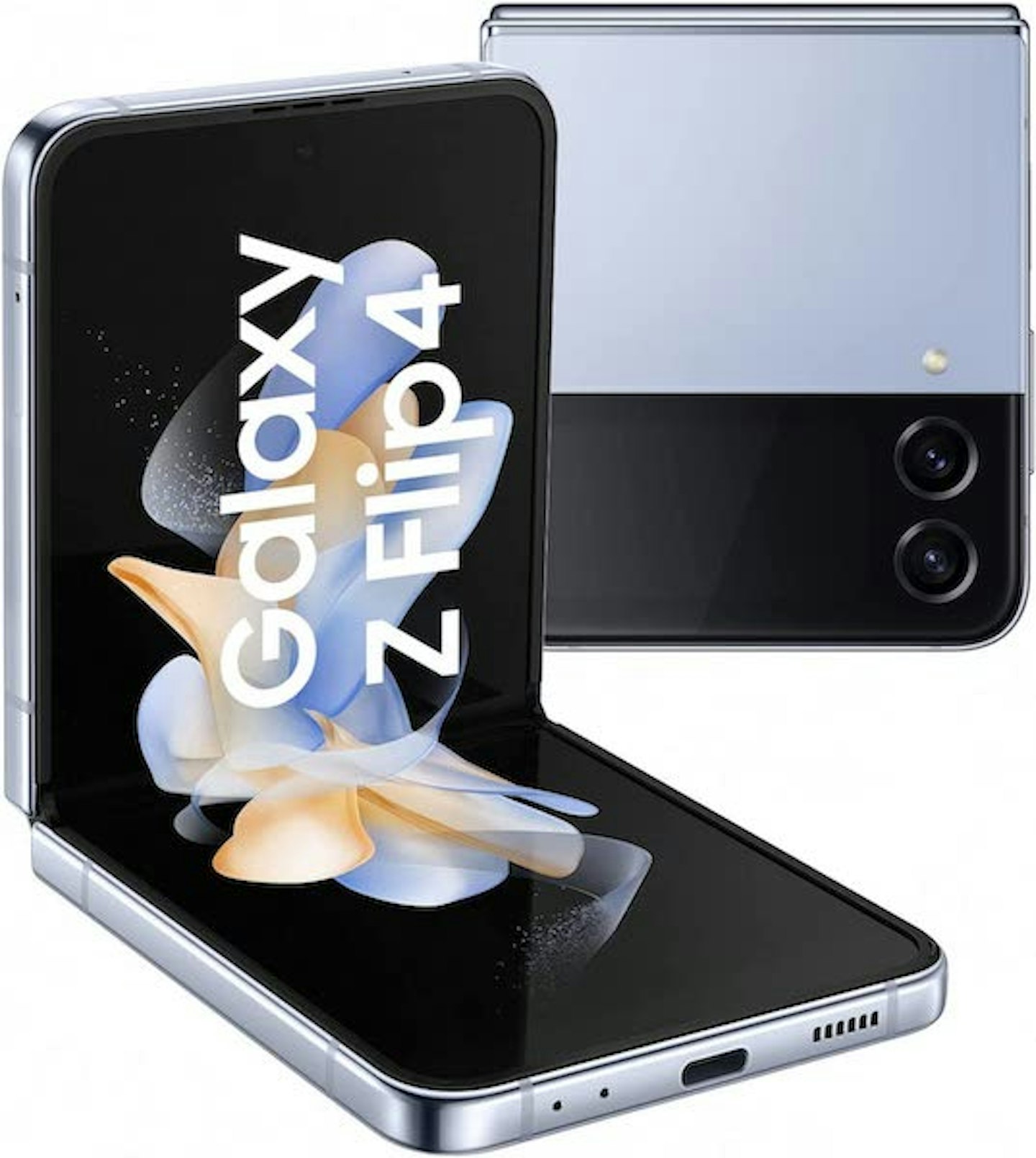As one ofthe best smartphones from the market leader, the Apple iPhone 14 Max Pro is, inevitably, the fastest, most versatile, and most expensive yet. However, it’s yet to migrate to the Apple Silicon ‘M1’ processor used in the iPad Pro; instead, it focuses on new camera technology and vastly improved battery life.
Richard Kilpatrick reviews the iPhone 14 Pro Max – and wonders if the £1,749 1TB option is remotely justifiable.
Verdict: Incremental improvements under the hood, but a new camera module finally gives the iPhone resolution to compete with Android devices. Impressive, intuitive and expensive, 256GB is enough for most uses
The Quick Version
You don’t need us to tell you what to expect from a new iPhone – you’ve had 14 years to see the once-thinkable device from the Cupertino computer makers achieve world domination through the palms and eyes of billions of users. The iPhone 14 Pro represents the polished, optimised cutting-edge of mobile technology without any big surprises, but a couple of giant leaps – most notably the 48MP main camera and everything that opens for video and photography. It’s expensive, it looks just like your old one, and you’re going to want it.
In this case, you’re not going to regret the upgrade if taking pictures and making movies is your passion, and if you’ve been holding off from retiring that iPhone 8, X or 11 this is significantly improved, nicer to hold and easier to use in many regards. If you’re happy with your iPhone 12 or 13, you might want to wait until the iPhone 15 and see if the leaps in camera tech are joined by processor bumps and USB-C support in the next generation.
Jump to:
What’s new in the iPhone 14?
At a glance, you won’t know if the phone’s a 12, 13 or 14, particularly in Pro Max 6.7-inch form. The body is almost identical, though the camera module is a touch larger. It’s got a brand-new 48MP main camera with improved HDR, movie and action modes; most images are still 12MP but it allows four zoom modes from three cameras without the pixelated mess of digital zoom.
The processor has moved up a generation to A16, though on paper it’s the same 6-core + 5 GPU of the iPhone 13’s A15. Memory bandwidth and clock speed improvements mean an 8-22% increase in performance; unlike Android handset makers Apple doesn’t give detailed specs.
The most obvious change on the iPhone 14 Pro is the departure of ‘The Notch’. It’s now a floating ‘Island’, and It’s probably the most intuitive new feature Apple has introduced to iOS for a while – it could be as significant as losing the home button, but in a positive way.
Finally, the iPhone 14 introduces iOS 16, which rolled out to compatible existing handsets (back to iPhone SE 2nd generation or iPhone 8) regardless of network, and has had several small fixes and improvements.
iPhone 14 Pro Max build quality
Long-term Apple users will be very comfortable with the ‘three generation’ model, and the 14 is the third evolution of the flat-sided, square camera module form factor introduced with the iPhone 12 (it recalls the iPhone 4’s ‘band’, and is a little easier to hold than the rounded flatness of the X). It’s more of a guideline than a hard and fast rule, but it does suggest that the iPhone 15 (XV?) could be the one for USB-C and Apple Silicon.
This years’ new colour is Deep Purple, and it’s a very Parma Violet shade, extending into the surgical stainless-steel band as a subtle wash and inevitably destined to be hidden inside a protective case. Weight, at 240g, reflects the glass and metal construction but isn’t unwieldy; for photographers it’s still less than many compact cameras. With the same protruding island of lenses and Lightning port as previous generations, it’s clear Apple’s not ready to make any revolutionary changes to the form factor.
Crucially, it's impressively rugged. During the period covered in this review the phone was dropped from six-foot-selfie height onto a concrete carpark in a simple open-fronted case; the case suffered a damaged corner but the phone's unmarked and working perfectly.
Buyers looking for a cheaper option may appreciate the iPhone 14 Plus rather than the Pro Max. It’s a similar size – which leads us nicely into the key differences between iPhone 14, and iPhone 14 Pro.
It’s the same formula as before; the Pro offers the ‘best’ tech, but the iPhone 14 is still a high-end handset. Key differences are:
• 12MP main (wide) camera vs 48MP camera in the Pro
• There are four lossless zoom levels on the iPhone 14 Pro camera array
• …and the iPhone 14 Pro and Pro Max have LIDAR for distance measuring
• The Pro’s display is capable of much higher levels of brightness
• The Pro has the ‘dynamic island’ instead of the notch
• Faster processing and better image processing in the Pro
• All iPhone 14s have the same amount of RAM, though
• Videographers will find more modes in the iPhone 14 Pro, including macro
• The iPhone 14 Pro uses stainless steel rather than aluminium
• But the iPhone 14 Plus will give you slightly more battery life
For most applications, games and productivity software, the iPhone 14 is more than adequate; the Pro and Pro Max are all about video, photography and creativity – and of course, the status of having the latest and greatest iPhone. As such, the iPhone Pro now offers up to 1TB of storage, though the 14’s 512GB is pretty impressive. Android handsets still have the edge here, frequently offering microSD card slots for memory expansion.
What’s a ‘Dynamic Island’?
No, it’s not an exciting rebrand for Britain. Apple has tried to hide the forward-facing and Face ID cameras ever since losing the front button and Touch ID, and the latest idea is to have a small pill-shaped area with some of the screen extending above it in the iPhone 14 Pro models. It becomes part of the interface as the black area of the screen expands to include Siri or music icons for quick access to controls, sports scores and other interactive notifications. The first applications generally show background progress or tasks, such as voice memo recording or timers counting down.
It makes the camera module feel less intrusive and ‘part of the system’ through some nice animations, and it does provide a neat way of interacting with media players and apps which will no doubt expand as more developers have ideas.
It also means that you’re encouraged to put your fingerprints all over the (also improved, 12MP autofocus) forward-facing camera when doing things like bringing up Spotify’s new ‘mini player’ control. Better keep a lens cloth handy before calling home or using Face ID.
iPhone 14 Pro and Pro Max camera: hidden depths and ProRAW

You’re gonna need a new case when you upgrade, despite the very similar shape to the iPhone 13. That’s because there’s a new lens and sensor array, and it’s more than just an incremental upgrade. With the iPhone 14 Pro and Pro Max, Apple introduces the first move away from 12MP sensors since they were introduced in the 6S Plus, featuring a 48-megapixel main camera and improved optical stabilisation.
All is not as it seems though, as most images remain 12MP, partly to maintain consistency with the 0.5x wide angle and 3x telephoto ‘zoom’, and partly to benefit from a technology called ‘binning’. Camera sensors rarely capture true colour per pixel, and usually, there is an arrangement of red, green or blue filters, one per pixel, and the colour image you see is calculated from that. The iPhone uses blocks of four pixels grouped under each colour to gather more light. But it can still separate out that fine detail if it needs to.

Camera improvements extend to the processing tech. You’ll see ‘Photonic Engine’ mentioned a lot – it’s a process of using multiple captures and stacking them for the best exposures, colours and effects, and it’s transparent to the user but immensely impressive. It’s one of the key advantages of an iPhone 14 over many Android alternatives; artificial intelligence algorithms are used to create colour, shape and shade with remarkable realism. It does mean that judging the camera performance technically is almost meaningless, but judging the final image is what counts.
Action mode compensates for extreme movement, and the 48MP sensor allows the three-lens setup to provide four levels of zoom, as there’s a 2x digital crop from the main camera that’s lossless, whereas any zooming other than the wide or superwide on two-lens iPhones is simply cropping your 12MP image.
Although most users will stick with 12MP files and enjoy all the magic the iPhone does in the background, the full 48MP resolution is available in ProRAW mode, enabled in settings then switched on or off as you would HDR or Live Photos. ProRAW creates a DNG file readable by most processing apps such as Adobe Lightroom, and it unlocks the full dynamic range as well as the resolution of the native 48MP sensor.
The results: Crop or Zoom, it’s impressive.
I put the iPhone 14 camera through its paces at Beamish Open Air Museum indoors and outside, trying out the slow-motion video, action and ProRAW modes. The conclusion you want to hear is ‘it’s basically foolproof and flawless’; the same stability you expect from an iPhone but compared with previous generations, richer colours in long exposures, faster operation and impressive stability.
Looking at the sensor and lens strengths, the 3x lens and 12MP sensor is still the best you will get for a distant subject but shooting with the 48MP sensor and cropping a section from the image is astoundingly successful, with crisp, clear details suggesting a lens of remarkable quality. Check the images below for an illustration of what the new camera modules can achieve.

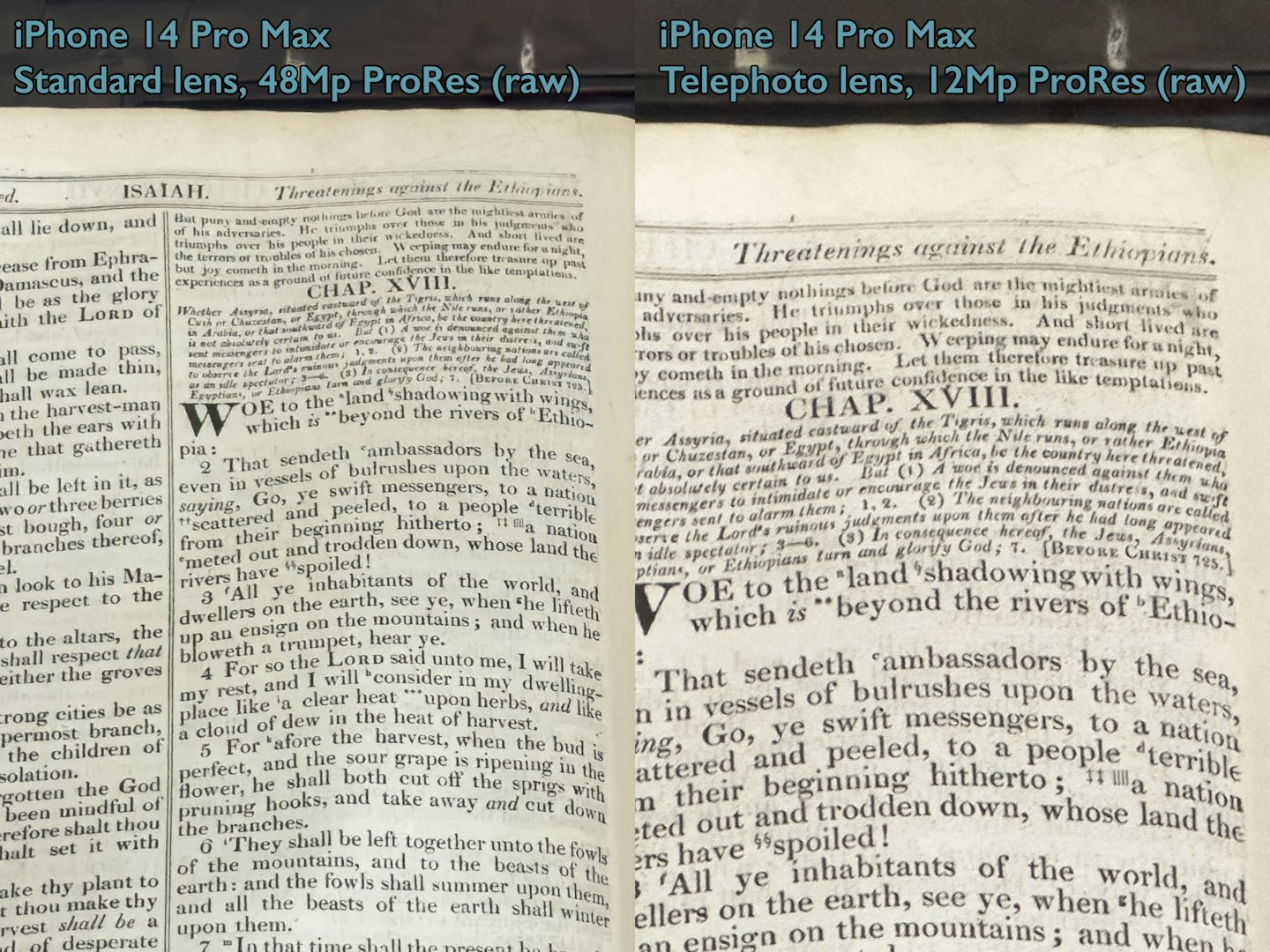

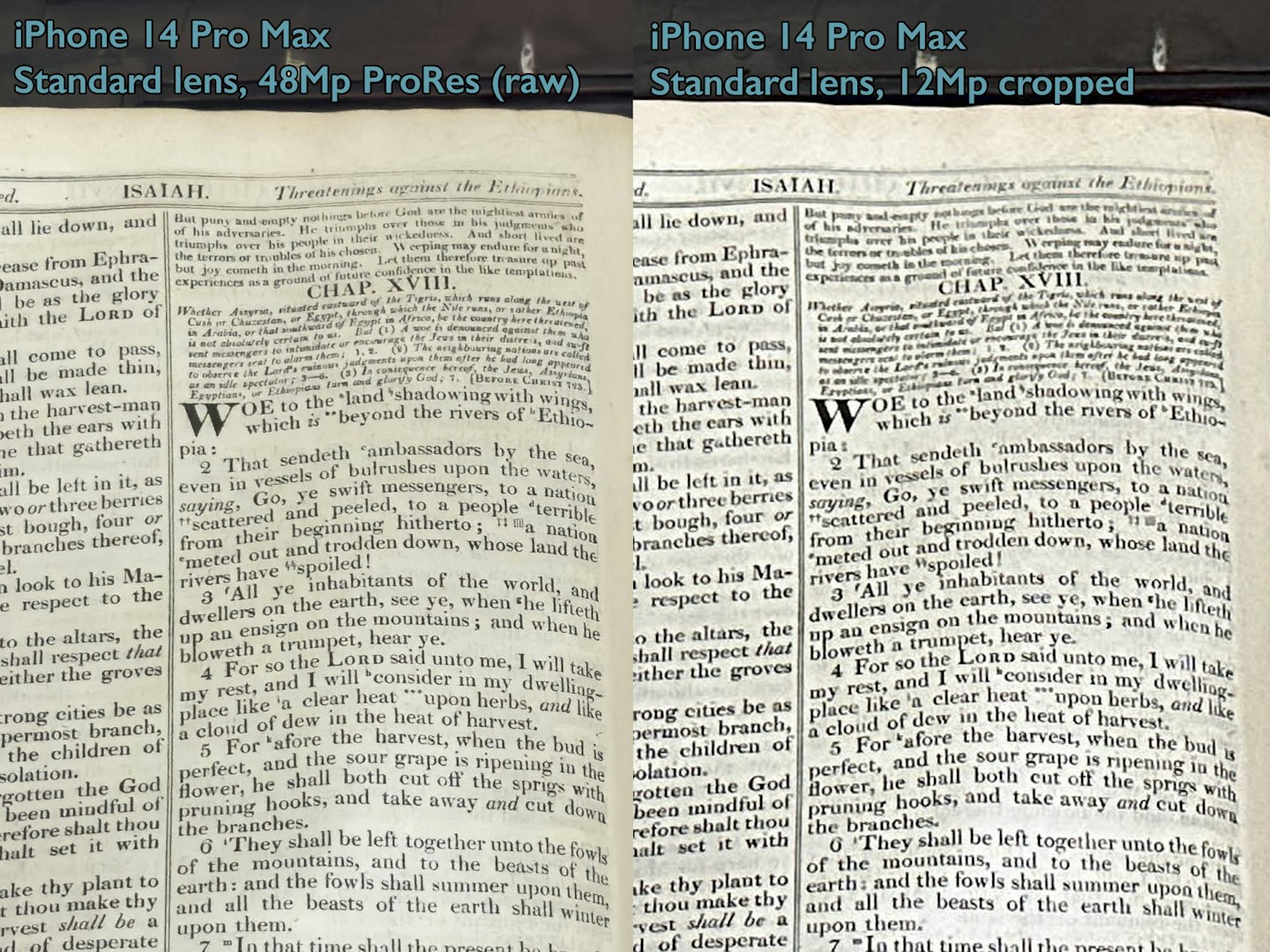
RAW files tend to be a little underexposed when loaded into Adobe Lightroom, but shadow recovery does not seem to reveal too much noise unless going to extremes; recent versions of Adobe Camera Raw (and Lightroom) include an Apple ProRes profile that is much better and reveals just how much latitude there is for post-processing.
Portrait mode has become incredibly good, too. No more background and foreground details blurring together, and the strength of this artificial depth of field extend to ‘Cinema Mode’ videos where the focus and aperture can be adjusted after filming.

Already good enough to satisfy most users, the iPhone 14 Pro camera offers immense flexibility for creative enthusiasts and professional photographers, and it’s a serious upgrade over previous generations that, somehow, manages to be just as easy to use. Plus, that incredible resolution and stability combined with immense processing power unlocks another skill – the iPhone 14 Pro can capture (OCR) text from photographs and documents with greater accuracy and speed than even Adobe's expensive Acrobat software.
Gaming and video: iPhone 14 Pro Max exceeds expectations
Most people use the iPhone for video and entertainment these days – it’s a wonder the word ‘phone’ is still in the name. The iPhone 14 Pro Max can deliver 29 hours of video according to the specifications; in the real world, it just works as you’d expect it to, seamless streaming, battery lasting well, not getting warm or struggling to handle what’s asked of it.
That, in part, is down to the streaming services being tailored to cope with more than just the cutting edge. It has a screen that is pushing 460 dots per inch and a resolution of 2,796 x 1,290 pixels. That Liquid Retina display is saturated, vibrant and sharper than I can see, but the real trick is the brightness. In daylight it can increase the brightness levels to a level where watching video outdoors is entirely realistic, though battery life will suffer.
Sound is very good, and spatial sound is supported on appropriate headphones or earbuds. It projects a very convincing stereo separation even when hand-held, and few mobile phones match the music playback offered by an iPhone pretending to be a radio. The built-in microphones are good for recording, voice notes and calls as well, though there’s a plethora of wired and wireless options for music, podcasting and hands-free calling.
Gaming is similarly limited by the need to reach the widest set of players, so nothing you get from Apple Arcade is going to challenge the iPhone 14’s processor and graphics. The dynamic island offers potential for real-world games, though – it’s capable of displaying live sports scores.
Where the iPhone 14 Pro comes into its element is shooting and editing video. The fast RAM, large storage option and powerful processor mean it’s entirely feasible to put a small movie together on, well, a phone. Adobe and Apple software provides powerful editing controls, and there’s a wealth of silly and serious video effects software (most of it, of course, is pretty bad and full of ads, but the serious paid apps are very good indeed). Cinematic mode now supports 4K video, and the Action stabilisation is, frankly, incredible – able to replicate some of the benefits of a gimbal when handheld and moving.
iPhone 14 Pro Max call quality
Signal strength and overall quality is dependent on your operator; my review is based on being with O2 (an experience I don’t recommend, purely because they do things like excluding the iPhone 14 from O2 Open, or giving you a short window to claim a free period of an O2 Extra you will ultimately pay for but is offered as a benefit of the package). 5G coverage is good but has more relevance for data and media – in terms of call and signal strength, the iPhone 14 maintained being on hold across 40 miles in a car, which is quite impressive.
Incoming and outgoing calls are clear, the speaker phone is exceptional, and of course, all the usual messaging apps and calling options are supported so voice messages in WhatsApp, Apple’s own messaging, and picture sharing all work as they should. You can easily ditch the landline. Yes, even for home broadband if your contract allows – though the phone can get warm when used for tethering, the bandwidth on 5G, if there aren’t too many people nearby, is quite impressive.
Verdict
It’s been a while since Apple has done anything revolutionary with the iPhone. At least two major upgrades seem to be held back; USB-C and Apple Silicon – but what you do get is a solid set of upgrades over the iPhone 13 and a significant leap forward from the 11 and 12s that will be coming to the end of their contracts. A new camera system borrows tech we’ve seen on Android for years, but with Apple quality, and that’s the iPhone 14’s biggest draw.
A safe buy, a satisfying buy, but if you think too hard about how much you’re spending for the higher storage options you may begin to question what that palm-sized vortex of information overload is really bringing to your life. Fortunately, the contracts are still competitive – and there’s a new selection of colours. Let’s face it, you’re going to want it – and Apple’s done just the right amount of tweaking without introducing any frustrations.
Pros:
Excellent quality throughout
Impressive camera upgrade
Beautiful screen
Cons:
1TB is expensive
Some device plans will show on your credit report as an unsecured loan
Not all wireless chargers like Magsafe
Specifications:
Dimensions: 160.7 x 77.6 x 7.9 mm
Weight: 240g
IP rating: IP68, dust & water resistant
Screen: 6.7 inches
Chipset: Apple A16 Bionic
Cameras: 48MP (Main), 12MP (Selfie)
Gadgets and gizmos: time for a new case?
Sorry, they’ve done it again. The iPhone 14 Pro and Pro Max might be almost exactly the same size as their 13 counterparts, but the camera module’s bigger. You’ll need a new case. MagSafe is supported for 15W wireless charging, your 20W USB charger will be enough for the iPhone 14 but the Pro Max can take 27W, and there are already countless silicone, leather, rugged plastic and clear acrylic cases on the market. Apple’s own cases are rather basic, but do the job – if you want something more individual, take a look at our guide to iPhone 14 cases and MagSafe accessories.
More items to consider:
How the product was tested
Upgrading from the iPhone 11, a standard migration and setup got the ball rolling. Call quality and signal have been tested from Portsmouth to Penicuik, and CarPlay's been put through four manufacturer's radios including an aftermarket double DIN Pioneer. Camera tests have been performed with studio and natural light, in dark conditions (at Beamish museum), and with images processed in Apple's own software, and as raw files exported to Adobe Lightroom. Assessment of camera performance is based on years of digital camera testing and use. App performance was measured using Roland Zenbeats and similar music apps and audio units for real-world experience. Finally, the review was updated after six months of living with the iPhone 14 for long-term impressions.
Richard Kilpatrick is a contributor at What's The Best. Well-versed in both technology and automotive, more can be found from Richard at Parkers.
Subscribe to the What’s The Best Newsletter to keep up to date with more of the latest reviews and recommendations from William and the rest of the What’s The Best team.
